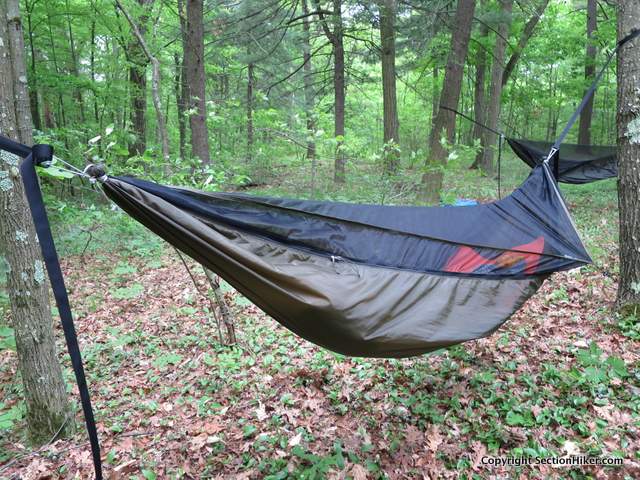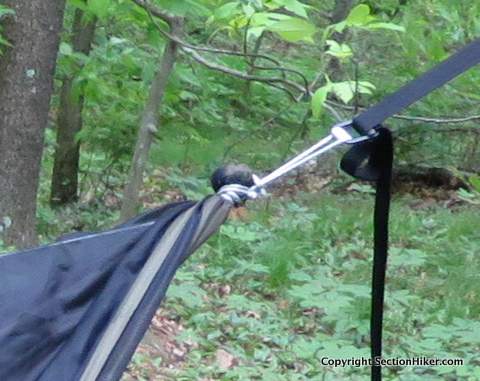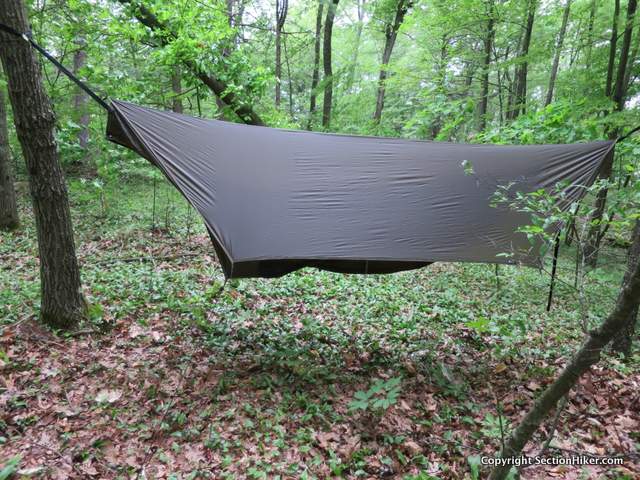
The NEMO Tetrapod Hammock is a full-featured, gathered-end backpacking hammock with a diagonal lay that weighs 33.5 ounces, not including stakes (on the SectionHiker scale) and comes complete with integrated mosquito netting, a tarp, and webbing straps. Originally designed for Special Operations Forces but now commercially available, it’s a single layer, side entry hammock, best used for warm-weather backpacking and camping.

The Tetrapod is made using 40d nylon with an 8-foot structural ridgeline rated up to 300 pounds and is 109″ long by 52″ wide. It comes with 2 x 8 foot webbing straps, each with one sewn loop end, that connect to the hammock using adjustable cinch buckles, a reliable and easy to use hammock suspension system designed for use with webbing straps.
The Tetrapod hammock has two wings that can be staked out using elastic guylines that form convenient gear shelves (like those found on the Warbonnet Blackbird) to store items you want close at hand. These were added at the request of the troops that NEMO designed this hammock for.

Yes, before you ask you can indeed lie on a diagonal in the Tetrapod, with your feet on the right or left of the centerline. If you’re sleeping in a hammock today without a diagonal lay, as it’s called, you owe it to yourself to upgrade. The comfort of being able to sleep flat on your back or on your side instead of like a banana is worth its weight in gold.
Finally, NEMO has attached a webbing loop to the outside of each cinch buckle, which they claim makes it easier to hold onto the hammock when putting it up and taking it down. You can see it in the photo above, on the left strap. I find them confusing and not particularly helpful. But more importantly – these webbing loops are not load-bearing, so don’t attach your suspension system to them.

Tetrapod Tarp
The NEMO Tetrapod comes with its own tarp, a nice addition since many hammock manufacturers make you purchase a tarp separately. The tarp is a fairly standard catenary cut hex fly. Also made with 40d silylon, it measures 130″ x 67″ with a ridgeline does not need to be seam-sealed because it’s sewn with thread that expands when it gets wet.
The tarp comes complete with paracord guylines, which are attached to sewn fabric loops along the perimeter. The guylines are not reflective, however, and I’d encourage you to swap them out with cord that is, something like Lawson Glowire, because it can be very difficult to find a hammock at night in dense forest, even with a headlamp.
The tarp ridgeline is configured as a split line suspension (a separate line for each side) and you’ll need to tie some kind of friction knot to tie the lines to trees since there isn’t any hardware provided. Given the size of the paracord, I’d suggest using two Figure 9 connectors, if knots aren’t your thing. If desired, there are multiple sewn loops on the ridgeline that would allow you to convert the tarp suspension to a continuous ridgeline suspension, using third-party products.

The ends of the tarp are a bit unusual however, with snaps that position the tarp ridgeline over the hammock’s webbing straps to block rain ingress like mini-doors. NEMO says these are designed to prevent rain from dripping down the hammock’s webbing, although I think they’re biggest benefit is to keep rain from blowing into the end of the tarp. If rain is likely, hang the tarp as close to the top of the hammock netting as possible without touching it, since the hammock will sag when you get into it.
The NEMO Hammock Tetrapod contains the following components:
- Color: Dark Green
- Tetrapod Hammock, including cinch buckles, 2 x wing guylines and structural ridgeline: 17.3 ounces
- Tetrapod Tarp, including guylines: 11.4 ounces
- 2 x 8 webbing straps: 3.9 ounces
- Bishop bag: 0.9 ounces
- Stakes: 8 included (requires 6), 4.5 ounces
Recommendation
The NEMO Tetrapod Hammock is a complete backpacking and camping hammock system the includes a tarp, integrated bug netting, and a structural ridgeline. Featuring a diagonal-style “lay”, the Tetrapod is designed so you can lie nearly flat (on your back or side) in the hammock at an angle to the centerline, which is much more comfortable than ultra-minimalist hammocks that make you sleep on your back and curved like a banana.
While self-contained and fully integrated, the Tetrapod is modular enough that you can upgrade some of its components to make it easier and faster to set up. But if you’ve been interested in trying a real backpacking hammock but are confused by all of the customization options and add-ons offered by smaller manufacturers or you want to upgrade from a banana hammock, I recommend you check out the NEMO Tetrapod. It’s in the same league as the best cottage manufacturer hammocks in terms of comfort and gear weight but doesn’t require that you get a PhD. in hammock fiddling to set up or use.
Disclosure: Philip Werner purchased this product with his own funds.
SectionHiker is reader-supported. We only make money if you purchase a product through our affiliate links. Help us continue to test and write unsponsored and independent gear reviews, beginner FAQs, and free hiking guides. SectionHiker.com Backpacking Gear Reviews and FAQs
SectionHiker.com Backpacking Gear Reviews and FAQs
Could you comment on the length of the hammock. Most cottage industry hammocks seem to be 10.5-11 feet long with 10-15 feet of suspension on each end. Do you feel an 8 foot hammock with 8 feet of suspension on each end is adequate for finding suitable trees to hang between? Price seems okay for total package, did you have the opportunity to get rained on?
I only measured the ridge line which is 8 feet, same as a Warbonnet. Far as I could tell it’s nearly identical to a blackbird. I’d prefer 10 or 12 ft straps, so I’d recommend replacing them. 8 feet is sufficient but not preferable.
by looking at the pics it appears to be shelved on each side……..?
Yes, both
Backcountry shows the dimensions at 98×50, so the hammock is 8.17 feet long. The Warbonnet Blackbird measures in at 120×63 and the Blackbird XLC at 132×63.
I’d caution you not to trust retailer websites specs completely for this product. I had a lot of problems with the specs that Nemo provided me. For example, the product you see pictures of on backcountry doesn’t actually match the product that is sold. I did measure the ridge line of my Warbonnet and it was also 8′, hence my previous remark. My bad for not also measuring the hammock body. Unfortunately, the hammock and I are in different locations at the moment, but I will post a measurement as soon as I get a chance to update it.
Let me elaborate. The product photos you see on retailer web sites show the fly as a birch green, which is the color of Nemo’s pre-production prototypes for this product. Nemo sent me one, which I sent back to them because it wasn’t production product. It was significantly different than the commercially available product which retailers are selling. I bought mine (which is the dark green shown in my review) at Backcountryedge.com. I’ve made Nemo aware of the photo and spec discrepancies, but I reckon it will be a while before the retail channel and web sites update the product photos or information.
Sorry for the delay. The actual measurements of the hammock at 109″ x 52″ which I’ve updated in the post. Like I said, pretty much everything on retailer web sites about this product is not up to date,
Right you are. I took the fabric spec from what Nemo published but figure it’s wrong. I didn’t experience any breathability issues when I slept in it. Figure it’s just nylon, but I’m not a fabric expert. Can’t tell one from another unless people tell me.
What is the benefit of replacing the ridgeline with a continuous ridgeline ?
None in my opinion but many people prefer it because they believe they can reposition the tarp more easily.
Looks interesting, would like to try one out at an outing. Thanks for the review.
Did you try it with an underquilt?
Just a pad – too warm already. No reason it won’t work though. It has a normal suspension.
I prefer the Warbonnet – from which Nemo’s design took many notes and clues.
Philip, thanks for the great review. Do you have a sense of the maximum user height this hammock will accomodate?
I’d say 6’6″ but call or email NEMO and ask if you are bigger than that.
I am just shy of 6’2″ with very broad shoulders and find it small.
have you used any of the Hennessy line and if so what is your comparison?
Yes – they’re in the same league. Hennessey has been at this game a lot longer and has more models for all kinds of specific needs and climates. Still this is an interesting offering. The side shelves are great.